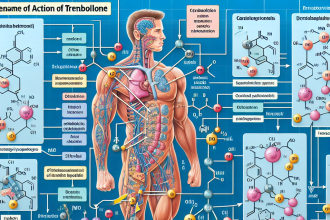History of Trenbolone: A Look at the Evolution of a Powerful Steroid
Trenbolone is a powerful anabolic steroid that has gained popularity among bodybuilders and athletes for its ability to increase muscle mass and strength. But what exactly is Trenbolone and where did it come from? In this article, we will take a closer look at the history, chemistry, and origins of this potent steroid.
The history of Trenbolone can be traced back to the 1960s when it was first developed by a pharmaceutical company called Roussel Uclaf. It was initially used as a veterinary drug to promote muscle growth in cattle and other livestock. However, it wasn’t until the 1970s that Trenbolone was introduced to the bodybuilding community.
During this time, Trenbolone was primarily used in its acetate form, known as Finaplix-H. It was administered to cattle by implanting pellets under their skin, which would slowly release the steroid into their system. Bodybuilders soon discovered that they could extract the pellets and convert them into an injectable form, making it easier to use for human consumption.
In the 1980s, Trenbolone gained even more popularity when it was included in a steroid stack known as “Finaject.” This stack, which also included Winstrol and Testosterone, was believed to be the ultimate combination for building muscle and strength. However, due to its high androgenic properties, Trenbolone was eventually discontinued for human use.
Despite its discontinuation, Trenbolone continued to be used by bodybuilders and athletes, who would often obtain it through the black market. In the 1990s, a new form of Trenbolone, known as Parabolan, was introduced by a French pharmaceutical company called Negma. This version of Trenbolone was considered to be more potent and had a longer half-life, making it more desirable for bodybuilders.
In the early 2000s, Trenbolone was once again discontinued for human use, and it became solely used in veterinary medicine. However, its popularity among bodybuilders and athletes continued to grow, and it is still widely used today, despite being illegal in most countries without a prescription.
Now that we have explored the history of Trenbolone, let’s take a closer look at its chemistry. Trenbolone is a modified form of the hormone Nandrolone, with an added double bond at the ninth and eleventh carbon positions. This modification makes Trenbolone more resistant to metabolism, allowing it to remain active in the body for longer periods.
Trenbolone is also highly androgenic, meaning it has a strong impact on the development of male characteristics. This is why it is often referred to as a “masculinizing” steroid. It also has a high anabolic rating, which means it is highly effective at promoting muscle growth and strength.
The origins of Trenbolone can be traced back to the hormone Testosterone, which is naturally produced in the body. Testosterone is responsible for the development of male characteristics, such as increased muscle mass and strength. Trenbolone is a modified version of Testosterone, with added chemical changes that make it more potent and effective.
In conclusion, Trenbolone has a rich history that dates back to the 1960s when it was first developed for veterinary use. Despite being discontinued for human use, it has remained a popular choice among bodybuilders and athletes due to its powerful effects on muscle growth and strength. Its chemistry and origins can be traced back to the hormone Testosterone, making it a highly effective and potent steroid. However, it is important to note that Trenbolone is a controlled substance and should only be used under the supervision of a medical professional.
The Chemistry Behind Trenbolone: Understanding Its Structure and Effects

Trenbolone is a powerful and controversial steroid that has gained popularity among bodybuilders and athletes for its ability to increase muscle mass and strength. However, its use has also been surrounded by controversy due to its potential side effects and misuse. In order to fully understand this compound, it is important to delve into its chemistry and origins.
Trenbolone was first synthesized in the late 1960s by a pharmaceutical company called Roussel Uclaf. It was initially developed as a veterinary drug to promote muscle growth in cattle. However, it was soon discovered that its effects were not limited to animals and it gained attention in the bodybuilding community.
Chemically, trenbolone is a modified form of the hormone testosterone. It belongs to a class of compounds known as anabolic-androgenic steroids (AAS), which are synthetic versions of the male hormone testosterone. Trenbolone is derived from the base structure of testosterone by adding a double bond at the 9th and 11th positions, as well as a 17-beta hydroxyl group. These modifications make it more potent and resistant to breakdown in the body.
The chemical structure of trenbolone also gives it a high binding affinity to the androgen receptor, which is responsible for mediating the effects of testosterone. This means that it can easily bind to the receptor and exert its anabolic effects, such as increasing protein synthesis and promoting muscle growth. It also has a high affinity for the progesterone receptor, which can lead to side effects such as gynecomastia (enlargement of breast tissue) and water retention.
One of the unique characteristics of trenbolone is its resistance to the enzyme aromatase, which converts testosterone into estrogen. This means that it does not convert into estrogen in the body, making it a popular choice for those who are sensitive to estrogen-related side effects. However, this also means that it can suppress the body’s natural production of testosterone, leading to potential side effects such as decreased libido and testicular atrophy.
In addition to its anabolic effects, trenbolone also has a strong androgenic component. This means that it can promote the development of male characteristics, such as increased body hair and a deeper voice. It also has a high potential for androgenic side effects, such as acne, oily skin, and male pattern baldness.
The origins of trenbolone as a veterinary drug have also raised concerns about its safety for human use. In the past, it was used to increase muscle mass in cattle before slaughter, leading to concerns about the potential presence of harmful substances in the meat. However, it is important to note that the trenbolone used in veterinary medicine is a different form (trenbolone acetate) and is not approved for human use.
In recent years, there has been an increase in the use of trenbolone in the bodybuilding community, with some individuals using it in high doses and for extended periods of time. This has raised concerns about its potential for abuse and misuse, as well as its potential for serious side effects. It is important to note that the use of any AAS should always be done under the supervision of a medical professional and in accordance with recommended dosages.
In conclusion, trenbolone is a powerful and controversial steroid that has gained popularity for its ability to increase muscle mass and strength. Its chemical structure and origins as a veterinary drug have raised concerns about its safety and potential for misuse. It is important to understand the chemistry behind this compound in order to fully comprehend its effects and potential risks. As with any AAS, it should only be used under the guidance of a medical professional and in accordance with recommended dosages.
Origins of Trenbolone: How This Steroid Came to Be and Its Impact on the Fitness World
Trenbolone, also known as “Tren”, is a powerful anabolic steroid that has gained popularity in the fitness world for its ability to increase muscle mass and strength. But where did this steroid come from and how did it become so widely used? In this article, we will delve into the origins of Trenbolone and its impact on the fitness industry.
The history of Trenbolone dates back to the 1960s when it was first developed by a pharmaceutical company called Hoechst-Roussel. Initially, it was used as a veterinary drug to promote muscle growth in cattle. However, it wasn’t until the 1970s that Trenbolone was introduced to the bodybuilding community.
Trenbolone’s chemical structure is derived from the hormone testosterone, with some modifications that make it more potent and resistant to breakdown in the body. This makes it one of the most powerful steroids available, with an anabolic rating of 500, which is five times higher than testosterone. Its androgenic rating is also high at 500, making it a popular choice for those looking to increase muscle mass and strength.
The origins of Trenbolone can be traced back to the development of another anabolic steroid called Nandrolone. Nandrolone was first synthesized in the 1950s and was used to treat medical conditions such as anemia and osteoporosis. However, it was soon discovered that Nandrolone had a high rate of conversion to estrogen, leading to unwanted side effects such as water retention and gynecomastia.
To combat these side effects, scientists began to make modifications to the Nandrolone molecule, resulting in the creation of Trenbolone. These modifications included the removal of the 19th carbon atom and the addition of a double bond between the 9th and 11th carbon atoms. These changes made Trenbolone more resistant to aromatization, meaning it does not convert to estrogen in the body.
The introduction of Trenbolone to the bodybuilding community caused a stir, as it quickly gained a reputation for its ability to promote lean muscle mass and strength gains without the unwanted side effects of estrogen. It became a popular choice among bodybuilders and athletes looking to improve their performance and physique.
However, the use of Trenbolone is not without its risks. Like all anabolic steroids, it can have serious side effects if not used properly. These include liver toxicity, cardiovascular issues, and suppression of natural testosterone production. It is also a controlled substance in many countries, meaning it is illegal to possess or use without a prescription.
Despite these risks, Trenbolone continues to be a popular choice among bodybuilders and athletes. Its ability to promote lean muscle mass and strength gains, along with its resistance to estrogen conversion, make it a highly sought-after steroid. It has also been used in the medical field to treat muscle wasting diseases and to aid in recovery from severe burns.
In conclusion, Trenbolone has a rich history that can be traced back to the 1960s when it was first developed as a veterinary drug. Its chemical structure is derived from testosterone, with modifications that make it more potent and resistant to breakdown in the body. Its impact on the fitness industry has been significant, with its ability to promote lean muscle mass and strength gains without the unwanted side effects of estrogen. However, it is important to use Trenbolone responsibly and under the guidance of a medical professional to avoid potential risks and side effects.




